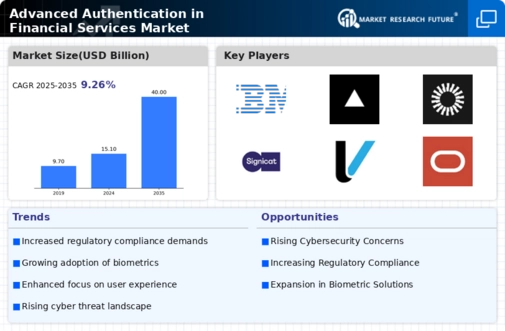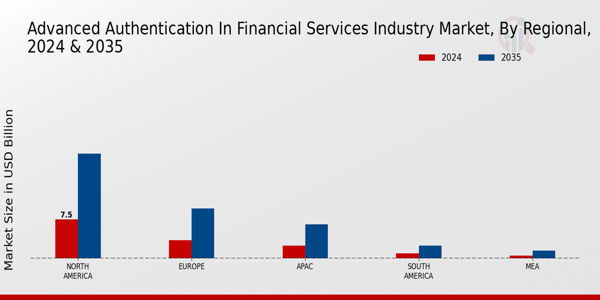Market Growth Projections
The Global Advanced Authentication in Financial Services Market Industry is poised for substantial growth, with projections indicating a market size of 15.1 USD Billion in 2024 and an anticipated increase to 40 USD Billion by 2035. This growth trajectory suggests a compound annual growth rate (CAGR) of 9.26% from 2025 to 2035. Such figures reflect the increasing recognition of the importance of advanced authentication solutions in safeguarding financial transactions and customer data. As financial institutions continue to invest in innovative technologies to enhance security, the market is likely to expand significantly, driven by the convergence of regulatory demands, consumer expectations, and technological advancements.
Increasing Cybersecurity Threats
The Global Advanced Authentication in Financial Services Market Industry is experiencing heightened demand due to the escalating threats posed by cybercriminals. Financial institutions are increasingly targeted by sophisticated attacks, necessitating robust authentication solutions to safeguard sensitive data. In 2024, the market is projected to reach 15.1 USD Billion, reflecting a growing awareness of the need for enhanced security measures. As cyber threats evolve, organizations are compelled to adopt advanced authentication technologies, such as biometrics and multi-factor authentication, to mitigate risks and protect customer information. This trend underscores the critical importance of investing in advanced authentication solutions to maintain trust and security in the financial sector.
Regulatory Compliance Requirements
Regulatory frameworks are becoming increasingly stringent, compelling financial institutions to adopt advanced authentication measures. The Global Advanced Authentication in Financial Services Market Industry is influenced by regulations such as the General Data Protection Regulation (GDPR) and the Payment Services Directive 2 (PSD2), which mandate strong customer authentication. Compliance with these regulations not only protects consumers but also enhances the reputation of financial institutions. As the market evolves, organizations are likely to invest in advanced authentication solutions to ensure adherence to regulatory requirements, thereby fostering a secure environment for financial transactions. This regulatory landscape is expected to drive market growth significantly in the coming years.
Growing Adoption of Digital Banking
The shift towards digital banking is a pivotal driver for the Global Advanced Authentication in Financial Services Market Industry. As more consumers embrace online banking services, the demand for secure authentication methods intensifies. Financial institutions are increasingly implementing advanced authentication technologies to enhance user experience while ensuring security. The market is anticipated to grow from 15.1 USD Billion in 2024 to an estimated 40 USD Billion by 2035, indicating a robust compound annual growth rate (CAGR) of 9.26% from 2025 to 2035. This growth is fueled by the need for seamless yet secure access to digital banking platforms, highlighting the importance of advanced authentication in maintaining customer trust.
Consumer Awareness and Demand for Security
Consumer awareness regarding data security is a crucial factor influencing the Global Advanced Authentication in Financial Services Market Industry. As individuals become more informed about the risks associated with online transactions, they increasingly demand robust security measures from financial institutions. This heightened awareness drives organizations to adopt advanced authentication technologies to meet consumer expectations. Financial institutions that prioritize security are likely to gain a competitive edge, fostering customer loyalty and trust. As the market continues to evolve, the emphasis on consumer-driven security measures will play a vital role in shaping the strategies of financial service providers, ultimately contributing to market growth.
Technological Advancements in Authentication Solutions
Technological innovations are reshaping the Global Advanced Authentication in Financial Services Market Industry. The emergence of artificial intelligence and machine learning is enabling financial institutions to develop more sophisticated authentication systems. These technologies facilitate real-time risk assessment and adaptive authentication, enhancing security measures. As organizations seek to stay ahead of cyber threats, the integration of advanced technologies into authentication solutions is becoming paramount. This trend not only improves security but also streamlines user experiences, making it easier for customers to access their financial services securely. The continuous evolution of technology is likely to drive significant growth in the market as institutions invest in cutting-edge solutions.

























